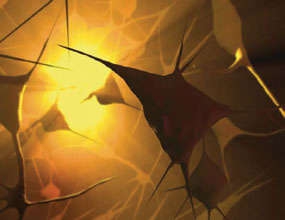A compound that appears promising for treating cocaine relapse is wending its way along a chain of discovery and trial that links NIDA's various Divisions. Its discovery occurred under a grant from the Division of Basic Neuroscience and Behavioral Research (DBNBR), NIDA's locus for studies into the fundamental brain mechanisms underlying drug abuse and addiction.
Dr. David Shurtleff, director of the Division, sees his unit as the base of a pyramid upon which other NIDA Divisions and the scientific community at large build. "Much NIDA-supported research hinges on a basic understanding of the important biological components of drug abuse and addiction and how we can modify them to treat this disease," says Dr. Shurtleff. "Our research in DBNBR, which probes the genetic, molecular, neurobiological, and behavioral levels, is fed to all other Divisions at NIDA for further studies and for development of medications and new behavioral treatments."
With an eye toward developing a new medication for treating cocaine relapse, DBNBR "handed over" the JDTic compound, a potent and selective kappa-opioid antagonist that has been shown to significantly reduce stress-induced cocaine relapse in rodents, to the Division of Pharmacotherapies and Medical Consequences of Drug Abuse for further tests in animals and—if warranted—in people. Ultimately, the compound may undergo large-scale clinical trials sponsored by NIDA's Clinical Trials Network.
The flow of research is two-way: As DBNBR feeds the findings of its grantees to other Divisions, it also relies on them for information that drives the development of its own research portfolio. For example, says Dr. Shurtleff, "The Division of Epidemiology, Services and Prevention Research tells DBNBR what the trends in drug abuse are and who is affected."
Key Research Components
DBNBR's research portfolio is divided among four Branches: Genetics and Molecular Neurobiology, headed by Dr. Jonathan Pollock; Behavioral and Cognitive Science, under Dr. Minda Lynch; Chemistry and Physiological Systems, under Dr. Rao Rapaka; and Functional Neuroscience, run by Dr. Nancy Pilotte. Investigations fall into the following categories:
- Genetic, which seeks to pinpoint genetic variations that make some individuals more susceptible to addiction;
- Developmental, which examines, primarily in animal models, the effects of drugs on prenatal development as well as on the still developing brains of children and adolescents;
- Behavioral, which looks at the consequences of drug abuse on behavior and cognition, providing important information for the design of treatment and prevention interventions; and
- Neurobiological, which delves into the processes and mechanisms in the brain and nervous system underlying addiction.
The research projects touch on a broad range of drugs, health problems, populations, and scientific disciplines. For example, teams of scientists specializing in virology, immunology, neuroscience, and other disciplines are trying to determine how and why some individuals with HIV/AIDS develop a type of dementia called neuro-AIDS and how exposure to neurotoxic drugs such as methamphetamine exacerbates this condition. Another study, by NIDA-supported scientists using technology developed by the California-based pharmacogenetics company Perlegen, Inc., is probing how genes affect tobacco addiction. The goal is to lay the groundwork for developing antismoking medications tailored to individuals who are genetically predisposed to nicotine addiction. Other nicotine studies focus on the effects of this drug on adolescents. Research by Dr. James Belluzzi and others shows that adolescent rats are more sensitive than adult rats to nicotine and that a combination of nicotine and acetaldehyde, another ingredient of cigarettes, is particularly addictive to the adolescents (see "Study Points to Acetaldehyde-Nicotine Combination in Adolescent Addiction (Archives)").
A number of studies are examining how drug abuse changes the brain's structure. They include research by Dr. Eric Nestler and colleagues looking at short- and long-term changes that cocaine engenders in the brain's limbic system and studies by Drs. Terry Robinson and Bryan Kolb indicating that repeated exposure to amphetamine and cocaine alters neuronal structures called dendrites, which, in turn, increases sensitivity to the drugs.
"Thanks to advances in neuroscience and genetics, we're finding answers to longstanding questions," Dr. Shurtleff notes. "Now we're able to view the human brain in action and understand how drug abuse affects the molecular mechanisms of cell signaling. As a result, we can develop new medications to stave off or reverse those effects. Information provided by the mapping of the mouse and human genomes is also helping us to answer longstanding questions about the etiology of drug addiction."
